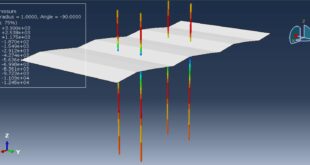In this tutorial, the Simulation pull-out test of a ribbed steel bar from Ultra-High-Performance-Fiber-Reinforced Concrete in Abaqus has been investigated. The steel bar is a three-dimensional model with full details. The UHPFRC part is modeled as a three-dimensional solid part. You can see a figure of the assembled parts below

Fiber-reinforced concrete is generally used to increase the dynamic behavior of concrete structures exposed to earthquakes, blasts, and impacts in military, passive defense, and retrofit projects. In addition to improving the toughness and ductility of concrete, fibers also improve its flexural and tensile strength, as well as its resistance to impact and dynamic loads. This reduces concrete fragmentation and crack propagation. The use of this kind of concrete has developed recently, and the analysis of its performance from various perspectives has received much attention. Since fiber-reinforced concrete is a composite material, its mechanical properties depend on the characteristics of the fibers (volume fraction, stiffness, geometrical properties, aspect ratio, and parameters of fiber bond-ing), concrete characteristics (compressive strength and type of materials), and other concrete additives, such as nanoparticles or pozzolanic materials
To model UHPFRC, the Concrete Damaged Plasticity material behavior with strain damage option is considered. The elastic-plastic material data is used for the ribbed steel bar. The dynamic explicit step with general contact capability is considered. The proper mesh and boundaries are assigned to all parts
After the simulation, all results such as stress, strain, damage, tension and compression damage, force-displacement diagram, and others are available. You can see a figure of the assembled parts below








 Abaqus tutorials Abaqus tutorials
Abaqus tutorials Abaqus tutorials




